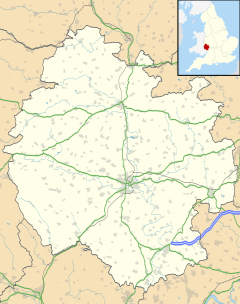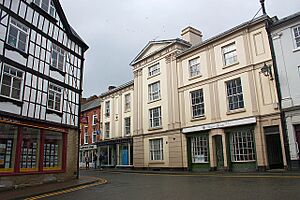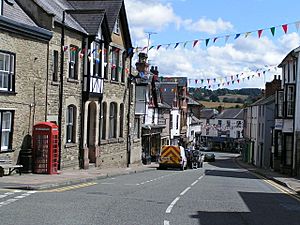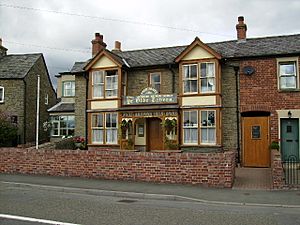Kington, Herefordshire facts for kids
Quick facts for kids Kington |
|
|---|---|
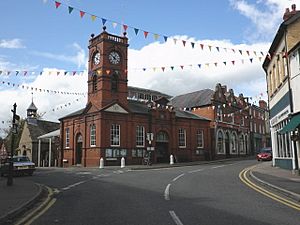 Kington's Market Hall |
|
| Population | 2,626 |
| OS grid reference | SO297566 |
| • London | 135 mi (217 km) ESE |
| Unitary authority | |
| Ceremonial county | |
| Region | |
| Country | England |
| Sovereign state | United Kingdom |
| Post town | Kington |
| Postcode district | HR5 |
| Dialling code | 01544 |
| Police | West Mercia |
| Fire | Hereford and Worcester |
| Ambulance | West Midlands |
| EU Parliament | West Midlands |
| UK Parliament |
|
Kington is a historic market town and civil parish in Herefordshire, England. It's a charming place with a rich history and beautiful surroundings. The parish where Kington is located has a population of about 3,240 people.
Contents
- Exploring Kington's Geography
- Kington's Past: A Brief History
- How Kington is Governed
- Kington's Population Over Time
- Kington's Weather and Climate
- Kington's Economy and Trade
- Learning in Kington: Education
- Getting Around: Transport in Kington
- Kington in the Media
- Sports and Activities in Kington
- Visiting Kington: Tourism
- Kington's Twin Town
- Famous People from Kington
- See also
Exploring Kington's Geography
Kington is located very close to the border with Wales, only about 3.2 kilometers (2 miles) away. It sits on the western side of Offa's Dyke, an ancient earthwork. The town is nestled near Hergest Ridge and lies on the River Arrow. The main A44 road crosses the river here.
Kington is about 30 kilometers (19 miles) northwest of Hereford, which is the main town of the county. Other nearby towns include Presteigne, Builth Wells, Knighton, and Leominster. The center of Kington is about 159 meters (522 feet) above sea level. The entire civil parish covers an area of about 348 hectares (860 acres).
Kington's Past: A Brief History
The name Kington comes from the old Anglo-Saxon words for "King's Town." This is similar to other nearby towns like Presteigne ("Priest's Town") and Knighton ("Knight's Town").
In 1066, before the Norman Conquest, Anglo-Saxons owned the land where Kington now stands. After the Normans took over England, Kington became part of the Crown's land. Around 1121, King Henry I gave Kington to Adam de Port. He started a new Marcher barony here.
Kington was once connected to the job of sheriff of Hereford. In 1172, another Adam de Port rebelled and had to leave the country. He came back in 1174 with a Scottish army but had to flee again. Because of this, Kington was taken by the Crown.
Later, in 1203, Kington was given to William de Braose, 4th Lord of Bramber. The Kington Castle saw some fighting during the Braose Wars against King John. It was likely destroyed by the king's forces in 1216.
A few years later, a new fortress was started, and the old Kington Castle was left behind. Today, all that remains of Kington Castle is a rocky outcrop with a few old earthworks. The original town was built around the castle and the Norman church on a hill above the River Arrow.
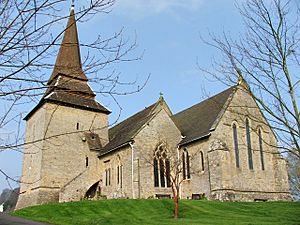
In 1086, Kington was recorded as 'Chingtune' in the Domesday Book. This name also meant 'king's town or manor.' The original settlement was high on the hill where St. Mary's Church now stands. The newer part of Kington, called Kyneton in the Fields, was planned between 1175 and 1230. It was built on land next to the River Arrow.
Kington became an important market town because it was on a direct route for drovers (people who moved livestock). It also had eight annual fairs. Even today, there is a busy livestock market on Thursdays. The town still has its old medieval street layout with narrow lanes.
Inside the chapel of St. Mary's Church, you can find the alabaster tomb of Sir Thomas Vaughan. He was from nearby Hergest Court and died in battle in 1469. People say the ghost of Sir Thomas, and also the Black Dog of Hergest, haunt the area around Hergest Ridge. Some believe seeing the Black Dog means someone will die soon.
How Kington is Governed
Kington has an electoral ward called Kington Town. This ward had a population of 3,240 people. The old Kington Town Hall building was finished in 1820.
Kington's Population Over Time
Here's how Kington's population has changed over the years:
| Population | Year |
|---|---|
| 1,424 | 1801 |
| 1,617 | 1811 |
| 1,820 | 1821 |
| 2,142 | 1831 |
| 2,091 | 1841 |
| 1,939 | 1851 |
| 2,178 | 1861 |
| 2,126 | 1871 |
| 2,952 | 1881 |
| 2,086 | 1891 |
| 1,944 | 1901 |
| 1,819 | 1911 |
| 1,688 | 1921 |
| 1,742 | 1931 |
| 1,890 | 1951 |
| 1,856 | 1961 |
| 1,915 | 1971 |
| 2,067 | 1981 |
| 2,147 | 1991 |
| 2,597 | 2001 |
| 3,240 | 2011 |
Kington's Weather and Climate
Like the rest of the UK, Kington has a maritime climate. This means it has mild temperatures throughout the year and moderate rainfall. The closest weather station is in Lyonshall, about 4 kilometers (2.5 miles) east of Kington.
The highest temperature ever recorded was 33.5°C (92.3°F) in August 1990. On average, the warmest day of the year is around 27.8°C (82.0°F). About 7.7 days a year reach 25.1°C (77.2°F) or higher.
The lowest temperature ever recorded was -16.5°C (2.3°F) in December 1981. Typically, there are about 44 nights a year when the temperature drops below freezing.
Kington gets about 845 millimeters (33.3 inches) of rain each year. It rains more than 1 millimeter (0.04 inches) on about 136 days a year. These averages are based on data from 1971 to 2000.
| Climate data for Lyonshall, elevation 155 m (509 ft), 1971–2000, extremes 1960–2007 | |||||||||||||
|---|---|---|---|---|---|---|---|---|---|---|---|---|---|
| Month | Jan | Feb | Mar | Apr | May | Jun | Jul | Aug | Sep | Oct | Nov | Dec | Year |
| Record high °C (°F) | 14.1 (57.4) |
16.8 (62.2) |
21.1 (70.0) |
24.0 (75.2) |
25.5 (77.9) |
31.2 (88.2) |
33.0 (91.4) |
33.5 (92.3) |
25.8 (78.4) |
21.5 (70.7) |
16.6 (61.9) |
14.4 (57.9) |
33.5 (92.3) |
| Mean daily maximum °C (°F) | 6.4 (43.5) |
6.7 (44.1) |
9.4 (48.9) |
11.9 (53.4) |
15.5 (59.9) |
18.3 (64.9) |
20.9 (69.6) |
20.4 (68.7) |
17.2 (63.0) |
13.1 (55.6) |
9.4 (48.9) |
7.3 (45.1) |
13.1 (55.6) |
| Mean daily minimum °C (°F) | 1.1 (34.0) |
1.0 (33.8) |
2.6 (36.7) |
3.9 (39.0) |
6.5 (43.7) |
9.3 (48.7) |
11.5 (52.7) |
11.1 (52.0) |
9.0 (48.2) |
6.3 (43.3) |
3.5 (38.3) |
2.0 (35.6) |
5.7 (42.3) |
| Record low °C (°F) | −15.8 (3.6) |
−12.8 (9.0) |
−10.6 (12.9) |
−4.2 (24.4) |
−2.2 (28.0) |
0.8 (33.4) |
2.2 (36.0) |
3.3 (37.9) |
−0.6 (30.9) |
−4.2 (24.4) |
−7.2 (19.0) |
−16.5 (2.3) |
−16.5 (2.3) |
| Average precipitation mm (inches) | 91.8 (3.61) |
68.0 (2.68) |
68.0 (2.68) |
58.6 (2.31) |
55.2 (2.17) |
59.2 (2.33) |
46.6 (1.83) |
62.8 (2.47) |
74.9 (2.95) |
81.9 (3.22) |
80.3 (3.16) |
98.5 (3.88) |
845.8 (33.29) |
| Source 1: Met Office | |||||||||||||
| Source 2: KNMI | |||||||||||||
Kington's Economy and Trade
In the 13th century, the new medieval town of Kington grew at the foot of the hill. It became an important market town for trading wool because it was on a key drovers' road. This historical location is why many long-distance footpaths, like the Mortimer Trail, the Herefordshire Trail, and the Offa's Dyke Path, pass through Kington today. The Black and White Village Trail also goes through local villages with their unique half-timbered houses.
In the 1870s, Kington was a busy trading center. It mainly traded with farmers from the nearby county of Radnor. There were two banks and a large factory that made iron, nails, and farm tools. Building and tanning (making leather) were also important trades. There were also corn mills and places for making malt. About 6.4 kilometers (4 miles) west of town were the Old Radnor lime rocks, known for their high-quality lime used in building and farming. Tuesday was market day, where people bought and sold eggs, butter, and poultry. It was a major meeting place for Welsh farmers and dealers.
During World War II, a large military camp called Kington Camp was built near the town. It was first used by British soldiers after the Dunkirk evacuation. Later, in 1943-44, two US General Hospitals were built there to care for wounded soldiers from Europe. These hospitals had many buildings, including labs, operating rooms, dental clinics, and even cinemas. Between 1944 and 1945, they treated 13,000 patients. After the war, the buildings were used by the Polish Resettlement Corps for Polish soldiers who didn't want to return to communist Poland. Many of the camp buildings are still standing today, and some are used by local businesses.
Kington's economy has faced challenges, partly because of changes in the farming industry. Its rural location and limited transport connections have meant higher unemployment for many years. Many jobs are part-time in small businesses, farming, retail, and services. There's a small tourist industry, mostly in the summer. Kington still feels like a quiet, unspoiled town on the border.
The traditional livestock market is still held on Thursdays off Duke Street, where farmers bring their animals. There's also a weekly food and crafts market every Friday, and a W.I. (Women's Institute) market on Friday mornings in Bridge Street, selling homemade goods. Kington's High Street has many unique and independent shops.
Kington Connected (KC3)
KC3 started in 1993 as a special project. Big companies like BT Group and Apple, along with government departments, chose Kington for a study. They wanted to see how new technology and advanced telecommunications could help small communities. Fifteen ISDN lines were installed for sending digital data. KC3 became a place where companies like ICI could have remote offices and payroll services. It also helped local businesses and schools with computer access and training.
In 2006, KC3 separated its business side from its community work. The community part stopped in 2007, and a new group called Marches Access Point continued to offer computer access and training. The business side became KC3.net, but it later ended in Kington in 2009. This project was even shown on the TV show The Net in June 1994.
Learning in Kington: Education
Kington has a primary school for younger students. It also has a combined secondary school and sixth form called Lady Hawkins' School. This school was founded thanks to Sir Francis Drake's cousin, Sir John Hawkins' wife, Lady Hawkins. In her will, she left money to the town to start the school. Lady Hawkins' School is special because it has permission from the Royal Navy to fly the White Ensign flag on its foundress day. Famous former students include singer Ellie Goulding and actress Jessica Raine.
Getting Around: Transport in Kington
The A44 road now goes around Kington on a bypass, instead of through the town center.
Bus services connect Kington to several towns, including Newtown, Powys, Llandrindod Wells, Knighton, Presteigne, Leominster, and Hereford. Kington has its own bus company, Sargeants Brothers, which started in the 1920s. Today, it provides bus services to Hereford and Mid Wales.
The Kington Tramway opened in 1820 and was used until railways took over. The Leominster and Kington Railway opened in August 1857. It was later taken over by the Great Western Railway. When the Kington and Eardisley Railway replaced the tramway in 1875, it built a new station in Kington. The old station became a place for goods.
Train traffic increased during World War II because of the US Army hospital camp nearby. However, after the war, train use declined. Passenger services stopped on February 5, 1955, and freight services ended in 1964. The tracks were then removed.
Today, the closest train station is Knighton on the Heart of Wales Line. However, Leominster is often quicker to drive to and has more frequent trains on the Welsh Marches Line. Bus services from Kington mostly connect to Hereford railway station and Llandrindod railway station.
Shobdon Aerodrome, a small airport, is also located close to the town.
Kington in the Media
Local news and TV shows for Kington are provided by BBC West Midlands and ITV Central. Television signals come from the Sutton Coldfield TV transmitter and a local relay.
Local radio stations include BBC Hereford and Worcester, Sunshine Radio, Capital Mid-Counties, Greatest Hits Radio Herefordshire & Worcestershire, and Hits Radio Herefordshire & Worcestershire.
The town is also served by the local newspaper, the Hereford Times.
Sports and Activities in Kington
Kington Golf Club is located on Bradnor Hill, about 391 meters (1284 feet) above sea level. This makes it the highest 18-hole golf club in England! The course opened in 1926 and was designed by Cecil Hutchison. It is 5,486 meters (6,000 yards) long and has no bunkers.
Kington Town F.C. is the local football team, and they play in the West Midlands (Regional) League.
Kington has also been the starting point for the Marin Rough (cycle) Ride, a cycling event, since 2003.
Visiting Kington: Tourism
The Kington Museum is open from April to September and is located on Mill Street in the town center. Near Kington, you can visit Hergest Croft Gardens, which are part of the Hergest Estate. These gardens are open to the public from March to October. In June, Kington hosts its annual Kington Festival for several weeks.
Ye Olde Tavern is a historic public house (pub) on Victoria Road. It was built in the late 1700s or early 1800s and is a Grade II listed building. It's even on the Campaign for Real Ale's list of historic pub interiors.
The Burton Hotel is a hotel and health center on Mill Street. Kington also has a Youth Hostel on Victoria Road, which is open from late March to late October.
Kington's Twin Town
Since 1979, Kington has been twinned with the town of Marines in northern France. Both places have a similar population size. In Marines, there's a street called "Place Kington," and in Kington, there's a covered area by the market hall called "Place-de-Marines."
Famous People from Kington
- Singer Ellie Goulding, Olympic equestrian Leslie Law, and actress Jessica Raine all attended Lady Hawkins' School in Kington.
- Stephen Kemble, who was part of the famous Kemble family of actors, was born here in 1758.
- Chris Menges, a cinematographer and film director, was born in Kington in 1940. He won two Oscars for his cinematography in The Killing Fields and The Mission.
- Composer Ernest John Moeran lived in Gravel Hill Villa in Kington starting in 1938. He composed several pieces there, including his Rhapsody, Sinfonietta, and parts of his Cello Concerto. He was also married in St Mary's Church in 1945.
- Pauline Murray, an actress known for playing Nurse Pauline in the 1966 film It Happened Here, passed away in Kington on New Year's Eve 1994.
- Australian artist Sidney Nolan lived a few miles north of Kington, near the Welsh border, from 1983 until he died. A trust in his name now supports the arts.
- Mike Oldfield, a musician, lived at The Beacon on Bradnor Hill near Kington in the mid-1970s. The nearby Hergest Ridge inspired his album of the same name. Oldfield even turned parts of his house into a recording studio, where he recorded his 1975 album Ommadawn.
- Ffransis G. Payne, a Welsh folklorist, author, and museum curator, was born in Kington.
See also
 In Spanish: Kington para niños
In Spanish: Kington para niños


